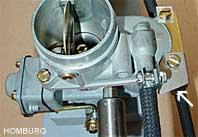I am still having these problems which I have not been able to resolve. Since my last post the car has been looked at by a carby expert and supposedly all is OK but the spark plugs are still sooted up so looks to be still running rich.
Went for a drive up a steep hill nearby (Black Mountain in Canberra) and the engine kept on loosing power - foot flat to the floor and it would start loosing power - backing off made things run a little better but when the engine died it would fire but not run - pointing downhill and all was fine. Engine runs fine on the flat and moderate hills but not steep hills.
The Carby is laid out the "right way" as in the top right diagram when going up hill.

My thoughts are that the engine is getting too rich when going up hill. So on the Series 1 32mm version of the carb, how do you adjust the float levels as I am thinking mine is a little too high. The floats in both carbies do not seem to have adjuster tabs. Also can anyone advise the psi that the series 1 fuel pump runs at - the electric pump I have may have too high fuel pressure.
As this carb is not the correct carb for the engine I have decided to get rid of it and get an original which is not easy to find. The closest is a carby off a Unimog 404 which I have purchased and it is in the mail to me. Should just need a kit and some rejetting.
Appreciate comments from the Series 1 Solex experts.
Cheers
Garry
REMLR 243
2007 Range Rover Sport TDV6
1977 FC 101
1976 Jaguar XJ12C
1973 Haflinger AP700
1971 Jaguar V12 E-Type Series 3 Roadster
1957 Series 1 88"
1957 Series 1 88" Station Wagon



 Reply With Quote
Reply With Quote

 . What sort of difference in height between the two levels should there be and if it is not right what can be done to adjust the level?
. What sort of difference in height between the two levels should there be and if it is not right what can be done to adjust the level?

Bookmarks